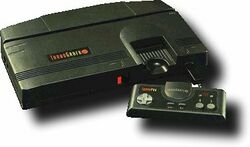Jump to navigation
Jump to search
m (Updating infobox) |
BrownDerby (talk | contribs) m (pc engine logo) |
||
| Line 4: | Line 4: | ||
|image=Tg-16.jpg | |image=Tg-16.jpg | ||
|manufacturer=[[NEC Corporation]] | |manufacturer=[[NEC Corporation]] | ||
| | |year=1989 | ||
|followed by=PC-FX | |followed by=PC-FX | ||
}} | }} | ||
| Line 11: | Line 10: | ||
A later version was released, which became the first video game console to have a CD-ROM peripheral, and to use CD-ROM as a storage medium for video games, as the [[TurboGrafx-CD]]. | A later version was released, which became the first video game console to have a CD-ROM peripheral, and to use CD-ROM as a storage medium for video games, as the [[TurboGrafx-CD]]. | ||
<gallery> | |||
File:PC Engine logo.svg|Japanese logo | |||
</gallery> | |||
[[Category:Fourth-generation consoles]] | [[Category:Fourth-generation consoles]] | ||
[[Category:NEC Corporation]] | [[Category:NEC Corporation]] | ||
Latest revision as of 07:02, 23 September 2022
| TurboGrafx-16 | |
|---|---|
 | |
 | |
| Manufacturer | NEC Corporation |
| Released | 1989 |
| Total Games | 328 (190 present) |
| ← (none) | PC-FX → |
The TurboGrafx-16 (known as the PC Engine in Japan) was NEC Corporation's first videogame console. Despite the "16" in its title, the TurboGrafx is an 8-bit system at heart (although it does have a 16-bit graphics chip).
A later version was released, which became the first video game console to have a CD-ROM peripheral, and to use CD-ROM as a storage medium for video games, as the TurboGrafx-CD.
-
Japanese logo
Subcategories
This category has the following 2 subcategories, out of 2 total.
Pages in category "TurboGrafx-16"
The following 188 pages are in this category, out of 188 total.
1
A
B
C
D
E
F
G
J
K
M
- Magical Chase
- Mahjong Gakuen Toumasou Shirou Toujou
- Mahjong Gakuen Toumasou Shirou Toujou Mild
- Maison Ikkoku
- Makai Hekkenden Shada
- Makyou Densetsu
- Mashin Eiyuuden Wataru
- Might and Magic, Book One: Secret of the Inner Sanctum
- Military Madness
- Moto Roader
- Moto Roader II
- Mr. Heli
- Mr. Heli no Daibouken
- Märchen Maze
N
P
S
- S.C.I. - Special Criminal Investigation
- Sadakichi Seven
- Saint Dragon
- Salamander
- Samurai Ghost
- Sengoku Mahjong
- Shanghai
- Shingen Samurai-Fighter
- Shinobi
- Shiryou Sensen: War of the Dead
- Shockman
- Sokoban World
- Soldier Blade
- SonSon II
- Space Harrier
- Space Invaders
- Splatterhouse
- Street Fighter II'
- Street Fighter II': Champion Edition
- Super Momotarou Dentetsu
- Super Momotarou Dentetsu II
- Super Star Soldier
- Super Volleyball
- Susano-o Densetsu

